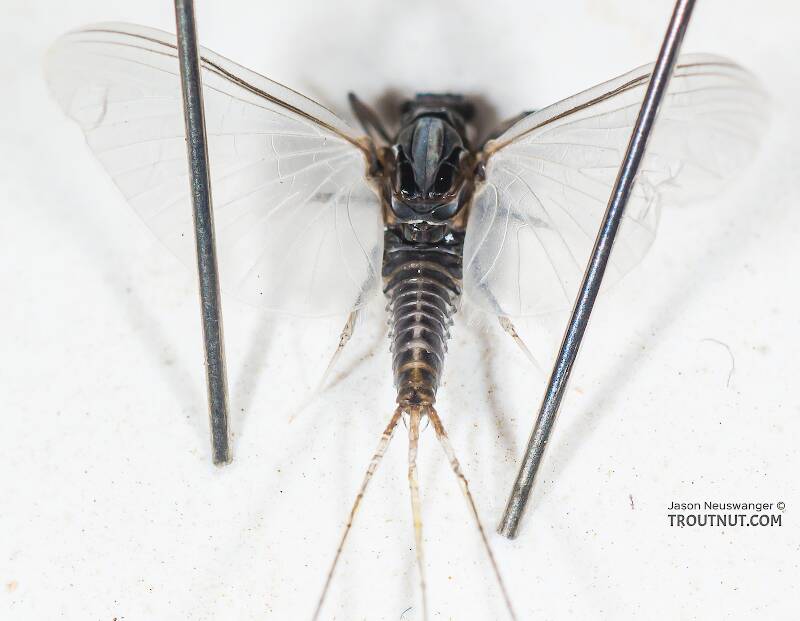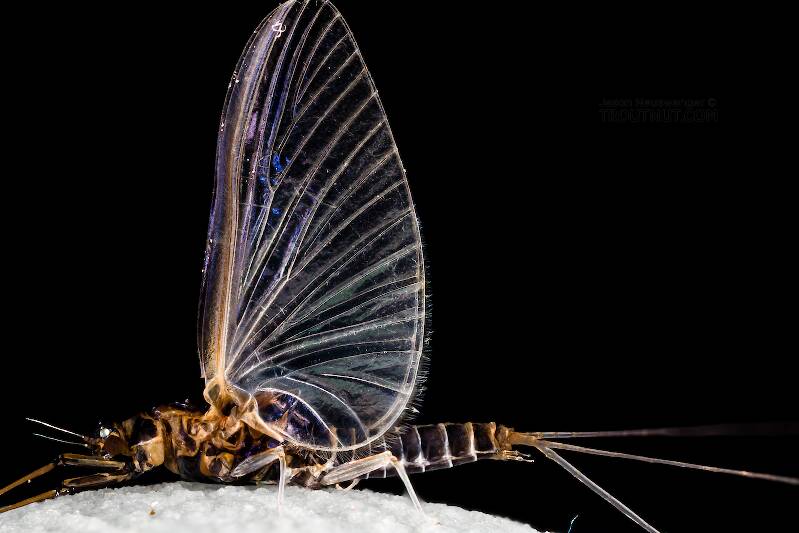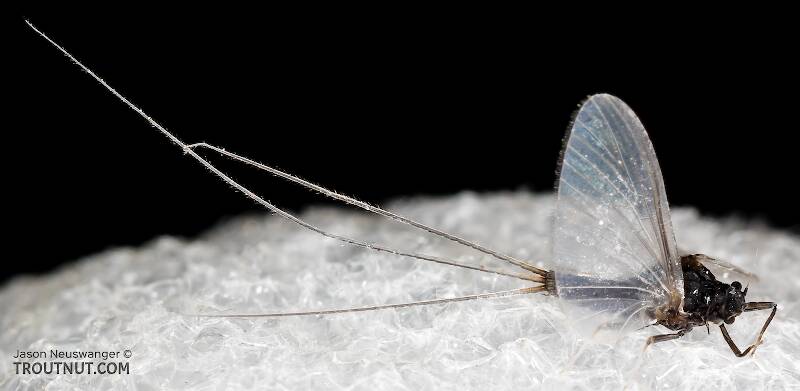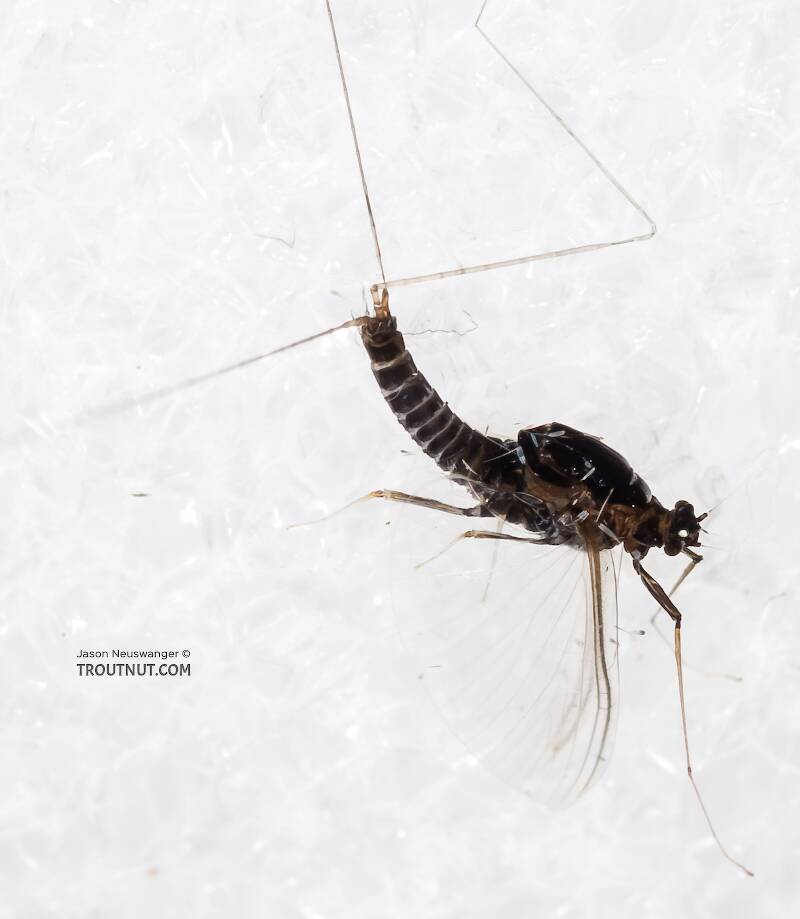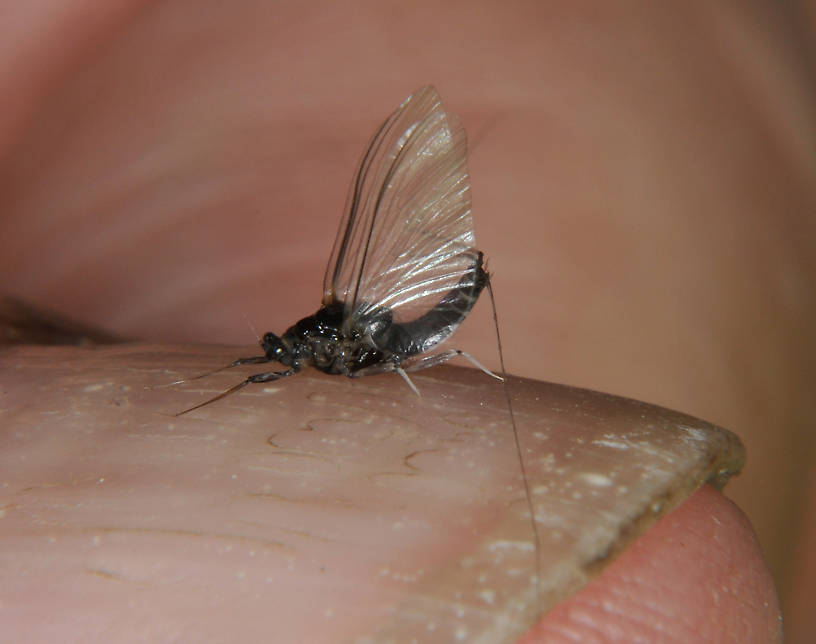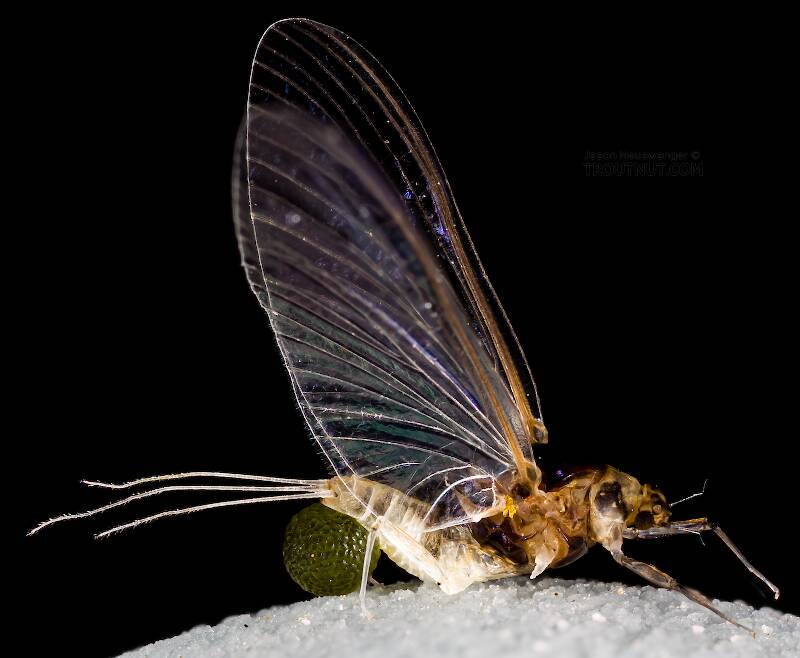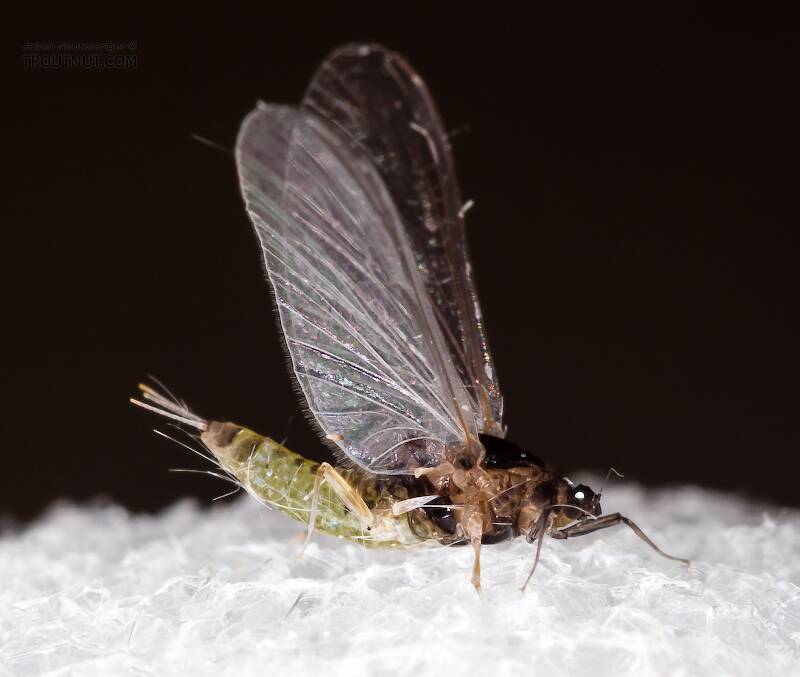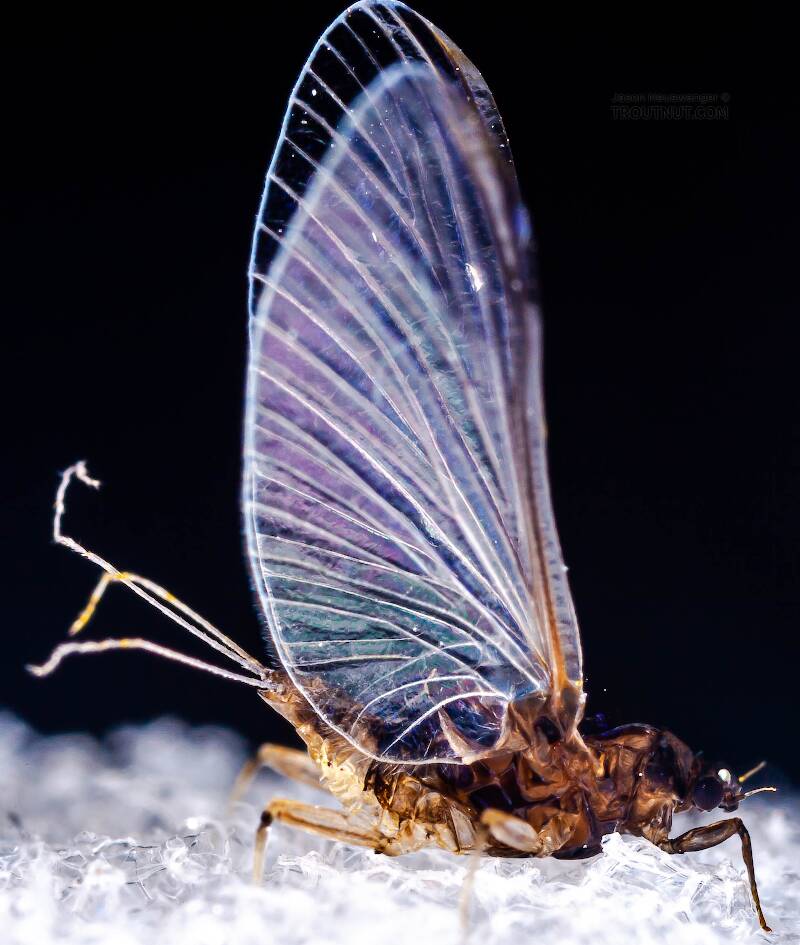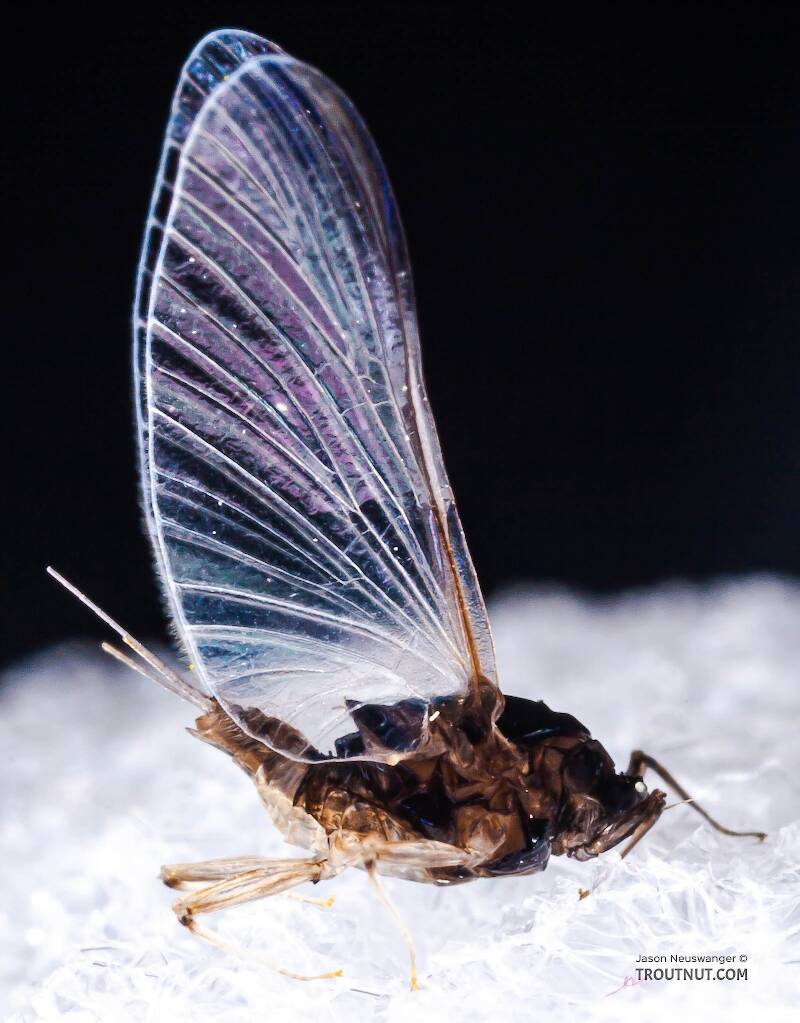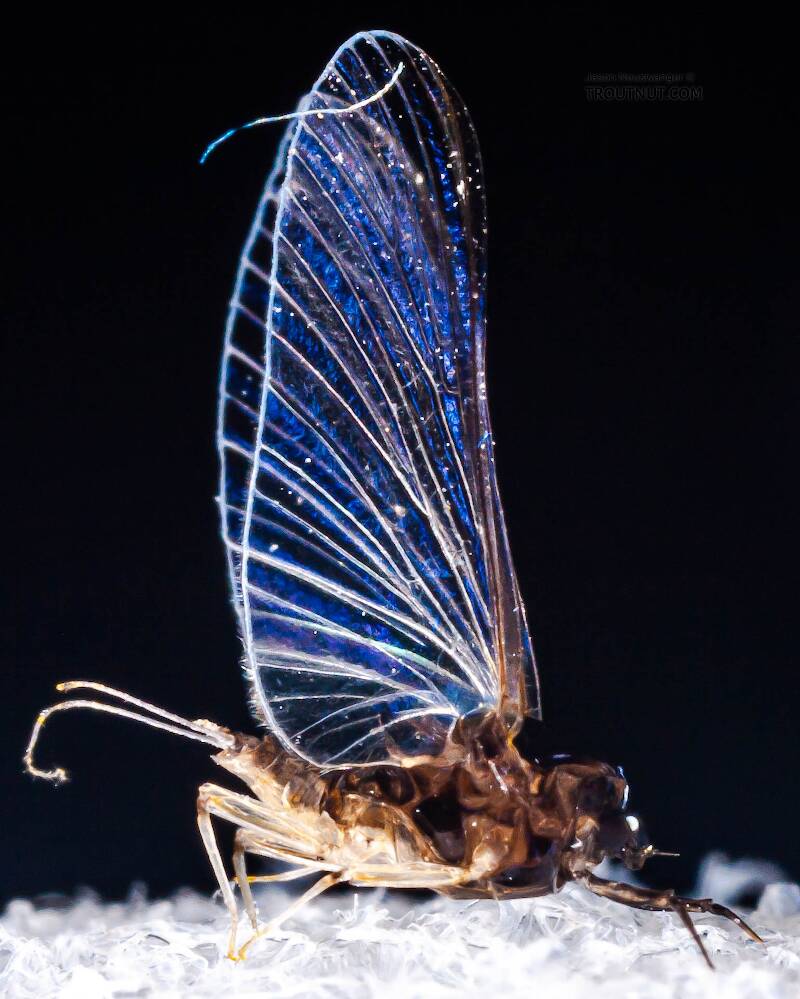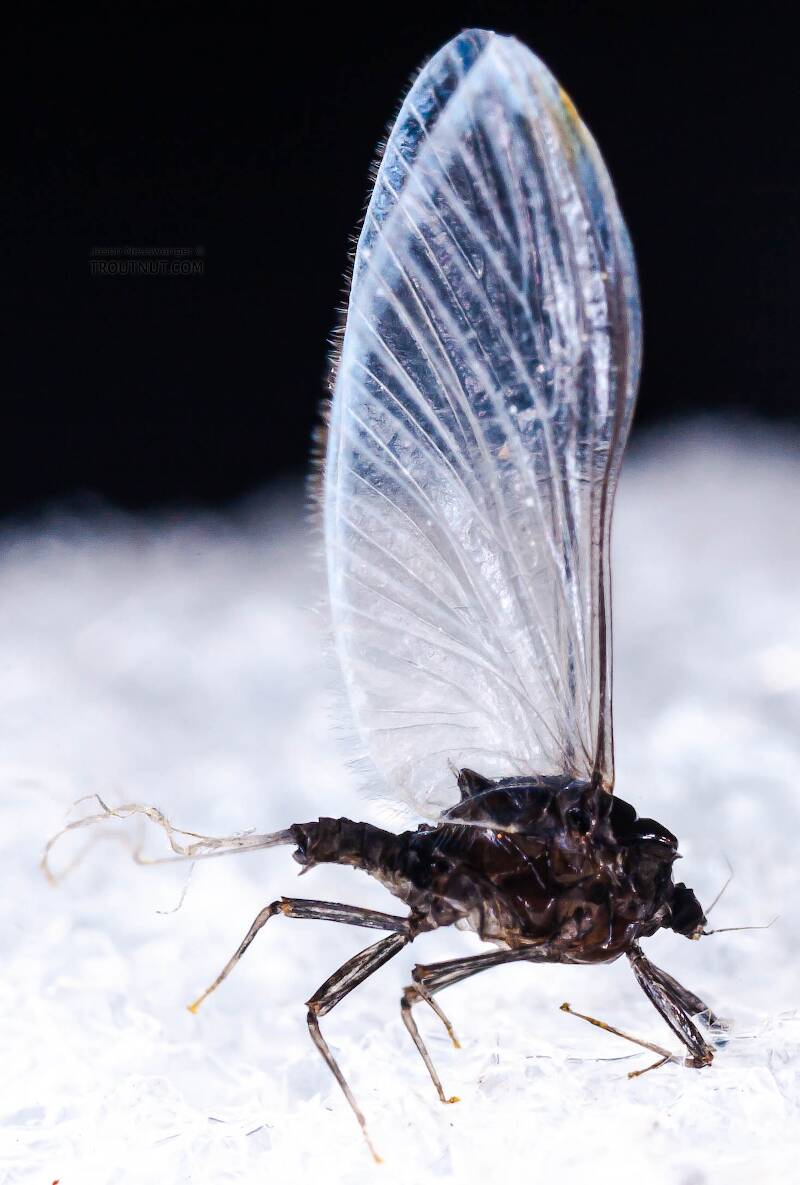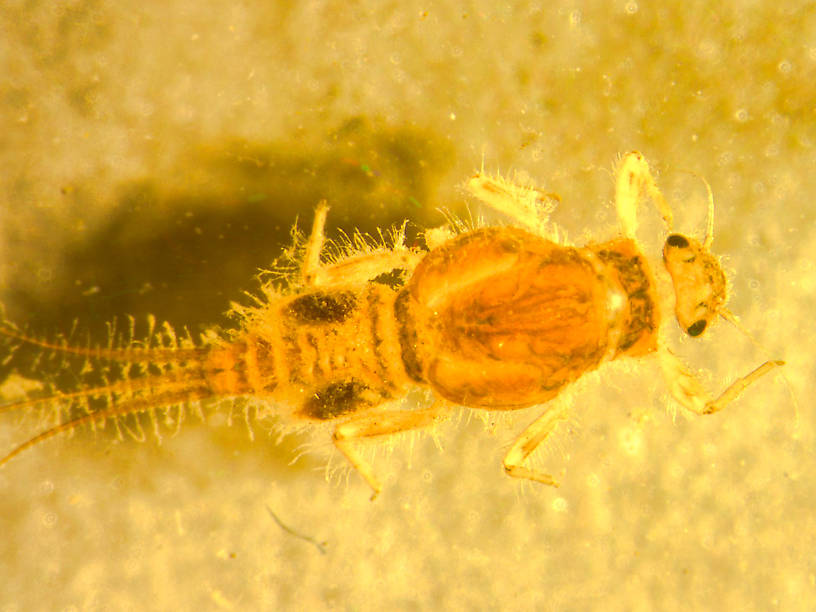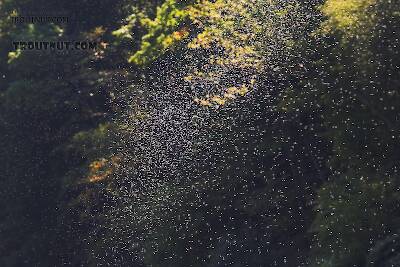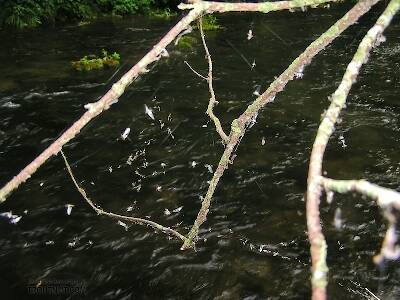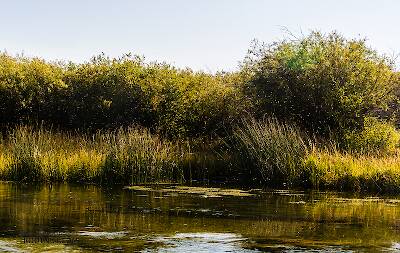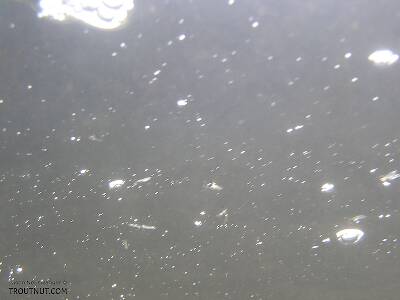
Hex Mayflies
Hexagenia limbata
The famous nocturnal Hex hatch of the Midwest (and a few other lucky locations) stirs to the surface mythically large brown trout that only touch streamers for the rest of the year.
Featured on the forum

Troutnut is a project started in 2003 by salmonid ecologist Jason "Troutnut" Neuswanger to help anglers and
fly tyers unabashedly embrace the entomological side of the sport. Learn more about Troutnut or
support the project for an enhanced experience here.
Mayfly Family Leptohyphidae (Tricos)
Read about the Tricorythodes genus for details. It is very important to trout anglers and it's the only significant trout stream genus in this family.
Most of the other genera are found only in warm waters in Mexico and the Southwest.
Most of the other genera are found only in warm waters in Mexico and the Southwest.
Where & when
In 93 records from GBIF, adults of this family have mostly been collected during July (26%), September (18%), August (16%), March (9%), October (8%), June (6%), and April (6%).
In 69 records from GBIF, this family has been collected at elevations ranging from 3 to 6470 ft, with an average (median) of 4137 ft.
Family Range
Identification
To determine whether a specimen of Ephemeroptera belongs to Leptohyphidae, use the Key to Families of Mayfly Nymphs or Key to Families of Mayfly Duns and Spinners.
Specimens of the Mayfly Family Leptohyphidae
1 Male Dun
4 Male Spinners
6 Female Spinners
2 Nymphs
3 Streamside Pictures of Leptohyphidae Mayflies:
1 Underwater Picture of Leptohyphidae Mayflies:
Discussions of Leptohyphidae
Trico emergers
6 replies
Posted by Bwoklink on Jul 14, 2018 in the genus Tricorythodes
Last reply on Sep 11, 2020 by Martinlf
Anyone have experience fishing Trico emergers patterns? I've had experience fishing the winged and spinner stage, but haven't heard of anyone fishing emergers during the early morning female hatch. Anyone used emerger patterns and if so would you might sharing which ones you have found effective?
Trico Tips
50 replies
Posted by Martinlf on Jul 21, 2007 in the genus Tricorythodes
Last reply on Jul 31, 2020 by Martinlf
I'll start with a fly patterns, follow with a bit of what I think I know about Tricos (Entomologists, please offer corrections if needed), and close with a few questions.
I love designing different patterns for Tricos, partly to keep myself entertained, and partly to show the fish something new from time to time. Jason's photos and the opinions of some fussy fish have led me to tie an extra large thorax recently on all my Tricos. My old standby is a parachute tied reverse, with a high vis post over the bend of the hook, and grizzly hackle, with no tails. It's modeled on Al's Trico, which could be found on the Little Lehigh Flyshop website until Rod closed the shop. An internet search may provide images now. It's very visible and fish generally approve. My newest fly is a take off from one of Gonzo's (Lloyd Gonzales) patterns in his book Fly-fishing Pressured Water, and it also shows the influence of Al's Trico. Gonzo ties an upside down Trico on a wide gap hook using synthetic material for the wing. I tie this fly also, and it certainly does catch fish, but I recently tied a version with grizzly hackle, making an oversize thorax and palmering hackle over the thorax to create a full wing. I then clipped hackle from the top of the fly (which becomes the bottom, as this is an upside down fly) so that the fly would sit flat, upside down, on my tying table. A drop of Locktite brush-on super glue on the bare recently clipped thorax after darkening the hackle stem with black marker and the fly was done. (By the way, I put tails on this one to balance it [P.S. Later correction: this pattern doesn't need the tails. I've caught plenty fish now on a tailless version] .) It caught several fish the first time I tried it on a heavily fished stream.
I believe for some, if not most species of Tricos, males hatch at night, females in the morning, and that the spinners fall when the air temperature hits the upper 60's. This generally means that as the season goes on, spinners hit the water later and later. Sometimes by 7:00 am (or earlier) in the early summer, by 10:00 (or later) in the fall.
It's been unseasonably cool in the Northeast the past couple of days, and I would have gone out this morning but for taking my daughter to a midnight showing of The Order of the Phoenix (I just couldn't get up) but I'm wondering if the spinner fall happens later than normal on cool mid-summer mornings like today's. I hope to find out Monday, but am curious if anyone has experiences to share. Also, does anyone have an effective Trico pattern to share? I'm always looking for ideas.
I love designing different patterns for Tricos, partly to keep myself entertained, and partly to show the fish something new from time to time. Jason's photos and the opinions of some fussy fish have led me to tie an extra large thorax recently on all my Tricos. My old standby is a parachute tied reverse, with a high vis post over the bend of the hook, and grizzly hackle, with no tails. It's modeled on Al's Trico, which could be found on the Little Lehigh Flyshop website until Rod closed the shop. An internet search may provide images now. It's very visible and fish generally approve. My newest fly is a take off from one of Gonzo's (Lloyd Gonzales) patterns in his book Fly-fishing Pressured Water, and it also shows the influence of Al's Trico. Gonzo ties an upside down Trico on a wide gap hook using synthetic material for the wing. I tie this fly also, and it certainly does catch fish, but I recently tied a version with grizzly hackle, making an oversize thorax and palmering hackle over the thorax to create a full wing. I then clipped hackle from the top of the fly (which becomes the bottom, as this is an upside down fly) so that the fly would sit flat, upside down, on my tying table. A drop of Locktite brush-on super glue on the bare recently clipped thorax after darkening the hackle stem with black marker and the fly was done. (By the way, I put tails on this one to balance it [P.S. Later correction: this pattern doesn't need the tails. I've caught plenty fish now on a tailless version] .) It caught several fish the first time I tried it on a heavily fished stream.
I believe for some, if not most species of Tricos, males hatch at night, females in the morning, and that the spinners fall when the air temperature hits the upper 60's. This generally means that as the season goes on, spinners hit the water later and later. Sometimes by 7:00 am (or earlier) in the early summer, by 10:00 (or later) in the fall.
It's been unseasonably cool in the Northeast the past couple of days, and I would have gone out this morning but for taking my daughter to a midnight showing of The Order of the Phoenix (I just couldn't get up) but I'm wondering if the spinner fall happens later than normal on cool mid-summer mornings like today's. I hope to find out Monday, but am curious if anyone has experiences to share. Also, does anyone have an effective Trico pattern to share? I'm always looking for ideas.
Differences I'm dying to know about
2 replies
Posted by Reify on Jul 8, 2018 in the genus Tricorythodes
Last reply on Jul 9, 2018 by Martinlf
What are the differences between Baetis, Caenis and Tricorythodes may flies. I get different answers from different FF buddies.
Thanks in advance
Thanks in advance
The Tully Trico season
10 replies
Posted by BioGriz on Jun 24, 2013 in the genus Tricorythodes
Last reply on Dec 17, 2013 by 12345
Preface: Any hatch where you are knee deep in trout rising and sipping bugs is awesome, regardeless if you are struggling to get a tight line. But on my home water the Tulpehocken Creek (Tully), which many of you from PA have fished before, Trico hatch brings problems...
1) Stressfull/unhealthy conditions for the trout. i.e. low water & high temps
2) A lot more fishing pressure from the "fair weather" community
I am a relative greenhorn compared to some of you who have decades of experience under your belt, and am just fishing for some general opinions here.
Had a great day at rebers using sze 22 trike spinner but i am noticing the tully temp is climbing. What kind of impact can we make on the stream? Is fishing in the morning and laying off the trout in the afternoon ok? or should the tully be left alone completely??
Thanks for your input!
1) Stressfull/unhealthy conditions for the trout. i.e. low water & high temps
2) A lot more fishing pressure from the "fair weather" community
I am a relative greenhorn compared to some of you who have decades of experience under your belt, and am just fishing for some general opinions here.
Had a great day at rebers using sze 22 trike spinner but i am noticing the tully temp is climbing. What kind of impact can we make on the stream? Is fishing in the morning and laying off the trout in the afternoon ok? or should the tully be left alone completely??
Thanks for your input!
Where To Find Trico Nymphs
3 replies
Posted by Lastchance on Jul 2, 2011 in the genus Tricorythodes
Last reply on Jul 10, 2011 by Entoman
Do they attach themselves in the silt near the shore? I'd like to study a few of them.
Thanks,
Bruce
Thanks,
Bruce
Start a Discussion of Leptohyphidae
References
- Arbona, Fred Jr. 1989. Mayflies, the Angler, and the Trout. Nick Lyons Books.
Mayfly Family Leptohyphidae (Tricos)
Taxonomy
Genus in Leptohyphidae: Leptohyphes, Tricorythodes
6 genera (Ableptemetes, Allenhyphes, Asioplax, Homoleptohyphes, Tricoryhyphes, and Vacupernius) aren't included.



